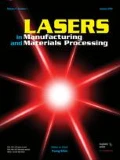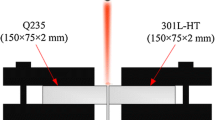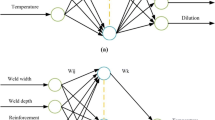Abstract
The shape and size of a weld bead - consisting of outer weld surface and inner fusion boundary - are important quality and strength attributes in sheet metal welds. The asymmetricity coupled with additional controlling parameters makes it challenging to predict the bead shape in laser-arc hybrid fillet-lap joints with use of lower order nonlinear analytical mathematical functions. An artificial neural network is designed to address the challenge, considering the welding speed, wire feed speed, voltage, current, and laser power as inputs. The experimentally obtained weld bead profiles are digitized in polar coordinates (r, θ) and thereby many input-output pairs are made available for training even with a limited number of experiments. An optimized neural network topology is presented with an assessment of reliability of simulation results. A rational approach for determining the number of coordinate points needed to accurately map the weld bead profile is an important contribution from the present investigation. The parametric study elucidates the effects of input parameters on geometry of the weld beads. The neural network exhibits the capability of capturing the process physics - demonstrated through the analysis of the weld dilution obtained from the simulation results. The welding speed and wire feed speed signifyingly affect the bead shape while the laser power has a minor impact. The laser, even though with less power, improves the weld dilution due to preheating of the base plate and stabilization of the welding arc.














Similar content being viewed by others
References
Ruifeng, L., et al.: A comparative study of laser beam welding and laser–MIG hybrid welding of Ti–Al–Zr–Fe titanium alloy. Mater. Sci. Eng. A. 528(3), 1138–1142 (2011)
Rayes, E., et al.: The influence of various hybrid welding parameters on bead geometry. Weld. J. 83(5), 147–153 (2004)
Gao, M., Mei, S., Wang, Z., Li, X., Zeng, X.: Process and joint characterizations of laser–MIG hybrid welding of AZ31 magnesium alloy. J. Mater. Process. Technol. 212(6), 1338–1346 (2012)
Seiji, K.: et al. Laser welding and hybrid welding of aluminium alloys. Proceedings of the International Aluminium Conference INALCO: 11, 79:90 (2010)
Lin-Jie, Z., et al.: Single pass hybrid laser–MIG welding of 4-mm thick copper without preheating. Mater. Des. 74, 1–18 (2015)
Sun, S., et al.: Multiple nonlinear regression model of weld beadshape for high nitrogen steel by laser-arc hybrid welding. J. Mech. Eng. 51(8), 67–75 (2015)
Abhay, S., et al.: Mathematical model of bead profile in high deposition welds. J. Mater. Process. Technol. 220, 65–75 (2015)
Saurav, D., et al.: Modeling and optimization of features of bead geometry including percentage dilution in submerged arc welding using mixture of fresh flux and fused slag. Int. J. Adv. Manuf. Technol. 36(11–12), 1080–1090 (2008)
Sanatan, C., et al.: Mathematical model of complex weld penetration profile: a case of square AC waveform arc welding. J. Manuf. Process. 30, 483–491 (2017)
Kumar, M.U., et al.: A semi-analytical nonlinear regression approach for weld profile prediction: a case of alternating current square waveform submerged arc welding of heat resistant steel. J. Manuf. Sci. Eng. 140(11), 1110–1113 (2018)
Ridings, G.E., Thomson, R.C., Thewlis, G.: Prediction of multiwire submerged arc weld bead shape using neural network modelling. Sci. Technol. Weld. Join. 7(5), 265–279 (2002)
Nagesh, D.S., Datta, G.L.: Prediction of weld bead geometry and penetration in shielded metal-arc welding using artificial neural networks. J. Mater. Process. Technol. 123(2), 303–312 (2002)
Cook, G.E., Barnett, R.J., Andersen, K., Strauss, A.M.: Weld modeling and control using artificial neural networks. IEEE Trans. Ind. Appl. 31(6), 1484–1491 (1995)
Chowdhury, S., et al.: Part Build Orientation Optimization and Neural Network-Based Geometry Compensation for Additive Manufacturing Process. J. Manuf. Sci. Eng. 140(3), 031009 (2018)
Juan, Z., et al.: An adaptive-network-based fuzzy inference system for classification of welding defects. NDT E Int. 43(3), 191–199 (2010)
Abhay, S., et al.: Artificial neural network modelling of deposition rate during twin-wire welding. Aust. Weld. J. 52, 39–48 (2007)
Abhay, S.: A comparative study on mechanical properties of single-and twin-wire welded joints through multi-objective meta-heuristic optimisation. Int. J. Manuf. Res. 11(4), 374–393 (2016)
Arpith, S., et al.: Prediction and optimization of weld bead geometry for electron beam welding of AISI 304 stainless steel. Int. J. Adv. Manuf. Technol. 89(1–4), 27–43 (2017)
Sukhomay, P., et al.: Artificial neural network modeling of weld joint strength prediction of a pulsed metal inert gas welding process using arc signals. J. Mater. Process. Technol. 202(1–3), 464–474 (2008)
Lakshminarayanan, A.K., Balasubramanian, V.: Comparison of RSM with ANN in predicting tensile strength of friction stir welded AA7039 aluminium alloy joints. Trans. Nonferrous Metals Soc. China. 19(1), 9–18 (2009)
Manikya, K.K., Srinivasa, R.P.: Prediction of bead geometry in pulsed GMA welding using back propagation neural network. J. Mater. Process. Technol. 200(1–3), 300–305 (2008)
Singh, A.K., Thorpe, G.R.: Simpson’s 1/3-rule of integration for unequal divisions of integration domain. J. Concr. Appl. Math. 1(3), 247–252 (2003)
Willmott, C.J., Kenji, M.: Advantages of the mean absolute error (MAE) over the root mean square error (RMSE) in assessing average model performance. Clim. Res. 30(1), 79–82 (2005)
Klas, N, et al. Parameter influence in CO2-laser/MIG hybrid welding. Annual Assembly of the International Institute of Welding: 56: (2003)
Jhaveri, P., et al.: The effect of plate thickness and radiation on heat flow in welding and cutting. Weld. J. 41, 6–12 (1962)
Kah, P.: Overview of the exploration status of laser-arc hybrid welding processes. Rev. Adv. Mater. Sci. 30, 112–132 (2012)
Acknowledgements
This research work is conducted as a part of a collaboration project of IIT Hyderabad and JWRI, Osaka University. Authors are thankful for their continued support.
Author information
Authors and Affiliations
Corresponding author
Additional information
Publisher’s Note
Springer Nature remains neutral with regard to jurisdictional claims in published maps and institutional affiliations.
Rights and permissions
About this article
Cite this article
Kochar, P., Sharma, A., Suga, T. et al. Prediction and Control of Asymmetric Bead Shape in Laser-Arc Hybrid Fillet-Lap Joints in Sheet Metal Welds. Lasers Manuf. Mater. Process. 6, 67–84 (2019). https://doi.org/10.1007/s40516-019-0081-y
Accepted:
Published:
Issue Date:
DOI: https://doi.org/10.1007/s40516-019-0081-y




